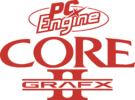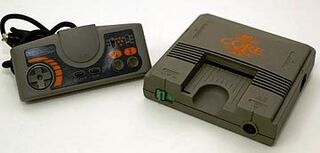Difference between revisions of "PC Engine CoreGrafx II"
From NEC Retro
m (Text replacement - "{{clear}} {{PCEngine}}" to "==References== <references/> {{PCEngine}}") |
|||
| Line 1: | Line 1: | ||
{{ConsoleBob | {{ConsoleBob | ||
| − | | | + | | logo=CoreGrafxII logo.png |
| consoleimage=CoreGrafxII set.jpg | | consoleimage=CoreGrafxII set.jpg | ||
| − | |||
| name= | | name= | ||
| maker=[[NEC]] | | maker=[[NEC]] | ||
Revision as of 04:38, 14 January 2022

| ||||||||||

| ||||||||||
| PC Engine CoreGrafx II | ||||||||||
|---|---|---|---|---|---|---|---|---|---|---|
| Manufacturer: NEC | ||||||||||
|
This short article is in need of work. You can help NEC Retro by adding to it.
The PC Engine CoreGrafx II (PCエンジンコアグラフィックス II) is an update to the PC Engine console, initially released in Japan in June 1991.
The CoreGrafx II was announced around the same period as the Super CD-ROM², and as with the original CoreGrafx and its relation to the PC Engine SuperGrafx, adopted its colour scheme. However, besides minor cosmetic changes and its lower asking price, the CoreGrafx II is thought to be identical to the original CoreGrafx (which in turn shared a similar build to the original PC Engine primarily so it could interface with hardware such as the CD-ROM²), to the point where commentators have questioned the need for its existence.
Physical scans
References
| PC Engine |
|---|
| PC Engine (1987) | CoreGrafx (1989) | CoreGrafx II (1991) X1 Twin (1987) | PC-KD863G (1988) | Shuttle (1989) | GT (1990) | LT (1991) |
| Add-Ons |
| AV Booster (1988) | Interface Unit (1988) | Ten no Koe 2 (1989) | Backup Booster (1989) | Backup Booster II (1989) | Ten no Koe Bank (1991) | Memory Base 128 (1993) |
